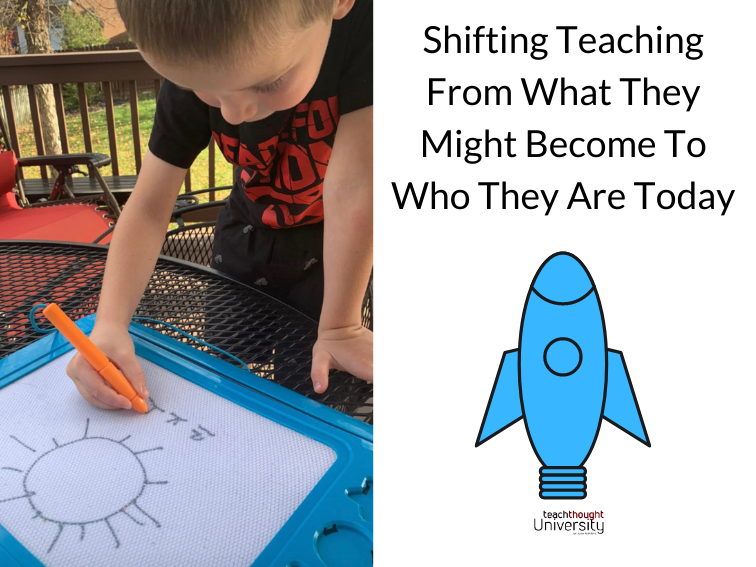
How I Shifted Teaching From What They Might Become To Who They Are Today
contributed by Luke Reynolds, Ph.D.
When I first started teaching English at a public high school near Hartford, CT, almost twenty years ago, like many new educators, I had one narrowing vision regarding what success would look like: nothing short of a block party with students standing atop their desks, shouting the words of Zora Neal Hurston, William Shakespeare, or Langston Hughes.
This big vision, of course, quickly broke down in the face of the reality in front and all around me: some students struggling with severe emotional issues, some with learning disabilities, some who had been kicked out of homes or, eventually, out of school, and others who seemed to not care about literature (or me) in the least.
See also Classroom Of The Future: Shifts To Move Tomorrow’s Learning To Today
Over time, that initially big vision became distilled into smaller aims, smaller goals: make eye contact with a student; laugh together; sit side by side and struggle through a particularly difficult line of poetry or prose; share a snack; high-five each student after a presentation; create and share hope.
These smaller goals—albeit possessing much less dramatic flair than my original, big one—began to create a classroom environment for greater depth, connection, and meaning. I began to see that one of the key pillars of an effective and authentic classroom was relational, not transactional. By engendering trust in the community of learners with whom I was housed for a year, we could, together, make gains that seemed on the surface e quite small, but on the greater scale of creating lives that were authentic and real, these gains could be much bigger.
In short, I let go of grand visions of ‘transformational teaching’ and instead focused on creating relational trust with my students—built on seeing them for who they are rather than what they might become.
Twenty-some odd years later, as we walk through a pandemic that wreaks havoc on our nation’s school systems, I want to extrapolate this small vision of a classroom to make a rather simple suggestion that we might, hopefully, receive as an imperative if we want to truly create classrooms that can cope with the inequalities this pandemic has exposed, as well as the everyday health and safety risks we now face.
My suggestion is neither new nor profound. But it has been, steadily and consistently, ignored by educational policymakers since, essentially, public schooling began in the 1850’s.
Smaller classes. If we can agree that classrooms—and students—function best when relational learning and a deep sense of trust can develop, then creating classrooms where no more than 12 (rather than 25 or, in some cases, up to 40) students are paired with a teacher would create a groundbreaking opportunity for students to shine and teachers to exhale.
I recall a teacher-mentor of mine, back when I was first starting out, sharing with me a simple mathematical formula that calculated what it would cost, in simple babysitting payment, to care for and keep safe 25 students for 6 – 8 hours a day. The sum amounted to an astronomically higher amount that any teacher had ever made for that same work—and yet we task our teachers not only with keeping kids safe and cared for, but also with, well, teaching, them, too! We task our teachers with becoming social workers, coaches, mentors, cheerleaders, instructional supports, and more, every single day in their classrooms.
Simultaneously, we task our students with retaining information at an ever-quickening pace, no doubt spurred on by spurious and often confusing (and sometimes downright dangerous) looming realities of high-stakes tests. In this context, how do we truly expect a culture of trust and authentic relationships to develop?
Rather than pressure, efficiency, and speed as the core values upon which we create schools, it is high time we exchange those values for three others: trust, meaning, and depth. These latter three values can—and will—emerge in beautiful and profound ways if we limit every classroom in America to 12 students for every teacher, thereby creating avenues to real connection based upon authenticity and growth, rather than a business model of transaction and efficiency.
If we scan the shiny, colorful websites of any private school in the nation, we find class size to be prominently featured on the main page in almost every single case. Don’t all our of children—not just those who can afford to spend $25,000 a year, deserve the right to a classroom built on getting to know one another, a classroom built on the fundamental principle that education—at its core—is a relational endeavor and not a transactional one?
If so, now is the perfect time to begin this transformation. By making our classroom smaller, we courageously invite our students into a very big vision of what it means to learn, now and for their futures.
Luke Reynolds, Ph.D, is an assistant professor of education at Endicott College, and a former middle and high school teacher. He is the author of several children’s books, including his latest book, Even More Fantastic Failures, is the second installment in his personal campaign to show kids it’s okay to fall down or make mistakes
